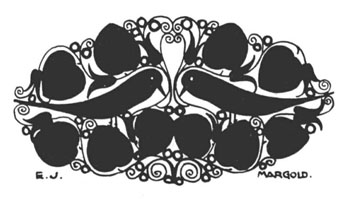Product Description
Emanuel Josef Mangold (attr.), J. & L. Lobmeyr (retailer), Fachschule Haida vase c. 1911



EMANUEL JOSEF MARGOLD attr. (1888-1962)
J. & L. LOBMEYR (founded 1823) Vienna, Austria
FACHSCHULE HAIDA Bohemia
Vase c. 1911
Stylized birds perched in highly stylized scrolling vine motif, abstract geometric circular forms and concave carved “windows”, “Schwarzlot” technique further accented with gilt highlights
For more information see: Das Böhmische Glas 1700-1950, Band IV Jugendstil in Böhmen, Alena Adlerová, c.s. (Passau: Passauer Glasmuseum, 1995) pp. 202 – 210; Glaskunst der Moderne: von Josef Hoffmann bis Wilhelm Wagenfeld, Torsten Bröhan (Munich: Klinkhardt & Biermann,1992),
***The “Schwarzlot” technique is finely pulverized iron that is in liquid form and painted as the graphic design. The piece is than “fired” and the painted surface creates a soft iridescent metallic charcoal grey surface. This technique also has a similar coloration to the liquid form metallic used in the silver / jewelry technique “Niello”. “Schwarzlot” was a labor intensive technique used in artistically painted glass in Bohemia immediately following the turn of the 20th Century and through the 1920’s.
H: 7 1/4″ x Dia” 4 1/2″
Price: $6,450
Emanuel Josef Margold (1888-1962)
The architect, designer for the arts and graphic artist Josef Emanuel Margold was trained as a carpenter at the College for woodworking in Königsberg an der Eger. He then studied at the School of Applied Arts in Mainz Anton Huber, then at the Academy of Fine Arts Vienna in the Master School of Architecture at Josef Hoffmann. 1908-10 he carried out works in Bohemia and Austria. He then became assistant Josef Hoffmann at the master class and employees of the Wiener Werkstätte. During the study period Margold participated in numerous Ideenwettbewerben. The Darmstadt publisher Alexander Koch became aware of him and published from 1907 Margolds designs in various journals.The 1911 Margold was appointed to the Darmstadt Artists’ Colony and established a studio in the Ernst-Ludwig-Haus. He made numerous designs for all areas of arts and crafts such as jewelry, porcelain, glass, fabrics and wallpapers. Documented from this period are also several residential and office equipment. His cookie jars made of sheet metal for the manufacturer Bahlsen from Hanover, which he made from 1912 to 1918 were known. In Darmstadt, he designed the establishment of the lamp business August Wilk and designed grave times in the expressionist style.In 1929 he moved to Berlin, where he still designed several houses in the style of the new style. In 1938 he became a professor at the School of Applied Arts
Emanuel Josef Mangold (attr.), J. & L. Lobmeyr (retailer), Fachschule Haida vase c. 1911
Eugene Fontenay (1823-1887) “Wisteria” brooch and fitted with original pendant attachment in 18k gold with extremely fine detailing, superb granulation and hanging pendant blossoms, marked: EF in a diamond poincon (the mark of Eugene Fontenay), French Eagle’s head touchmark for 18k gold (2x), c.1875
Length of pendant: 3 and 3/8 inches x width: 1 and ½ inches
Weight: .60 Troy ounce / 18.6 grams / 11.9 pennyweights
Matching French open wirework long necklace in 18k gold with fine detailing and delicate beadwork details, marked: TM in a diamond poincon (maker’s mark and possibly that of Michel Tricaud), French eagle’s head touchmark for 18k gold (3x), c.1875
Length: 58 inches long x width: 3/8 inches
Weight: 2.01 Troy ounces / 62.7 grams / 40.3 pennyweights
Pendant and necklace combined weight: 2.61 Troy ounces / 81.2 grams / 52.3 pennyweights
Nineteenth century French goldsmith Eugène Fontenay (1823-1887) was born into the profession, with a family name long known for their skills as goldsmiths. Fontenay opened his own studio in 1847 after apprenticing with Marchand and working for the Parisian jeweler Dutreih. Influenced by the archeological revival style of the period, a response to the Campana Collection of classical jewels, brought to France in 1861. Fontenay became an author as well, and published books including “Les Bijoux Anciens et Modernes” in 1887, after selling his workshop.
